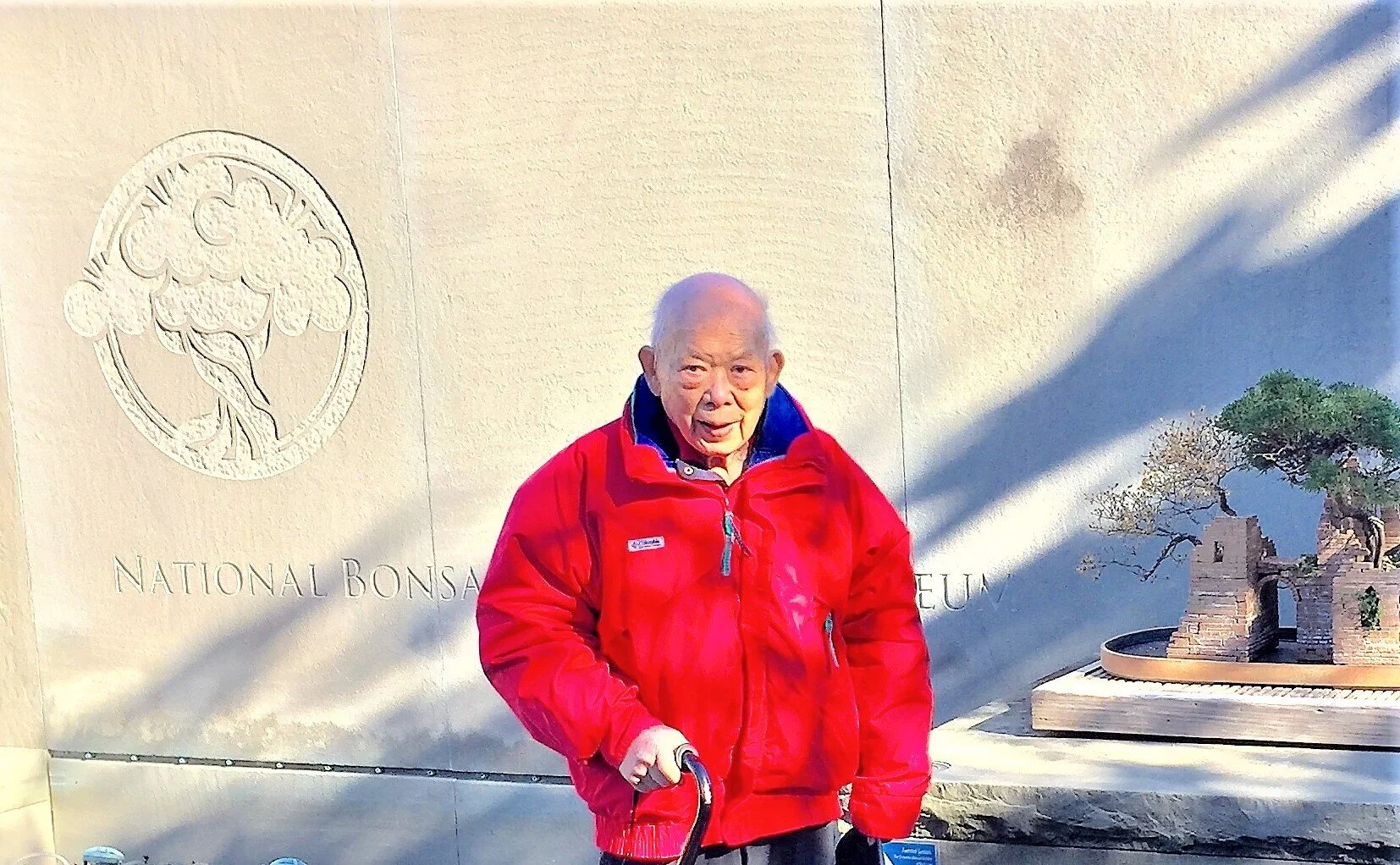Chin Fun Kwok in front of the National Bonsai & Penjing Museum entrance sign, photo credit: Glen Kwok
Members of the National Bonsai Foundation’s (NBF) Board of Directors often have hands-on bonsai experience, but not many of them can say they helped build parts of the National Bonsai & Penjing Museum. Chin Fun Kwok can.
As a former Museum volunteer who provided a comforting and friendly presence on the NBF board for 25 years, Kwok interacted with the Museum in a variety of ways. But his introduction to the Museum came by way of his engineering career.
Kwok was born in Hong Kong and went to school in Shanghai before traveling to the United States to study engineering at the University of Pennsylvania and Case Institute of Technology in Cleveland, now part of Case Western Reserve University.
He moved to Washington, D.C. in 1962 and joined the Veteran’s Administration in Hospital Design. After retiring in 1986, Kwok met former NBF director Bill Merritt, a fellow Case alumni, who invited him to work together on bonsai benches for the Museum’s recently developed North American Pavilion.
“At that point, I’d seen the Japanese collection before, and the people at the Museum brought me the energy to learn about bonsai,” Kwok said.
In July 1986, collectors Dr. Yee-sun Wu and Shu-ying Lui sent the U.S. National Arboretum a combined gift of 31 penjing from Hong Kong, and Wu offered to fund the creation of a pavilion to house the new trees. Wu supplied nine Chinese craftsmen to help with the project’s design.
Kwok helped advise on the early architectural design and selection decisions and eventually served as a translator between local and Chinese artisans working on the pavilion. He said Wu shipped over Chinese materials to use for the design, including porous rocks that were immersed in the water for thousands of years, wood doors and tiles for the walls.
“These hardworking people worked seven days a week and finished the job in nine weeks,” Kwok said. “We’re very proud today to see their beautiful work on the Chinese Pavilion.”
In his early horticulture days, he took bonsai lessons at the Arboretum from the Museum’s first curator, Robert Drechsler. Due to his travel schedule, Kwok said he mostly enjoyed simply watching other bonsai club members work on their trees.
“What I do is appreciate other people’s work all over the world,” he said.
After retirement, Kwok led and organized tours mainly to major Chinese cities like Guangzhou, Shanghai and Nanjing. He said he was amazed to see the vast collections of penjing and commercial bonsai on his trips to China.
Though he didn’t keep up his personal bonsai practice, Kwok attended many bonsai demonstrations and events for 30 years through the Northern Virginia Bonsai Society.
CF Kwok with his family at the National Bonsai & Penjing Museum in 2019, photo credit: Chih-Yi Chen
After working on various projects at the Arboretum, Kwok was invited to join the National Bonsai Foundation’s Board of Directors. He often helped NBF develop relationships and facilitate conversations with Chinese visitors.
“I was able to translate or help with whatever I could,” Kwok said. “It was a pleasure to be able to listen to all the experts all the time.”
Kwok’s favorite memories from his tenure as an NBF board member are tied to his time volunteering and working on trees at the Museum with other board members. He also became friendly with bonsai masters like John Naka, who have trees in the collection.
“We were fortunate to have excellent, dedicated staff and board members, and it was always pleasant to talk to them,” Kwok said. “I enjoyed the friendships I made with them and the members of the Potomac Bonsai Club. Hats off to the most dedicated volunteers who give untold hours of meticulous care and maintenance to the bonsai collections.”
He added that the art of bonsai has traditionally been passed down through generations – trees were grown within the family. But he’s now enthused to see the unlimited potential of bonsai for younger crowds through the widespread availability of lectures and demonstrations. Kwok enjoys when up-and-coming generations of bonsai experts share what they have been learning about the art.
“There are two kinds of people – the kind that grows bonsai and enjoys the process and the kind that just uses their eyes or hands to appreciate them, the lazy ones like me,” he said. “I enjoy the beauty of other people’s hard work. It is so relaxing to see these beautiful plants, especially when you see before-and-after pictures that make you much more appreciative of the artist who developed the shape.”
NBF appreciates the many years of camaraderie and experience Kwok brought to the Museum. We thank him for his contributions and know the trees and Museum overall are in better shape because of his generosity, talent and steadfast appreciation for the art and spirit of bonsai.



